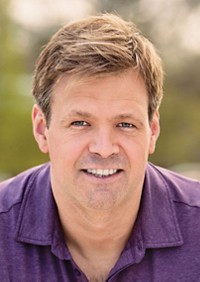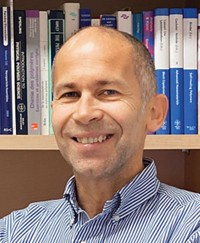Thomas H. Epps III and LaShanda Korley can’t seem to escape each other’s gravity. The two polymer scientists first met at a conference more than 2 decades ago, as students. Soon after, they each emerged as rising stars in the field of soft matter.

Credit: Kathy F. Atkinson/University of Delaware
Thomas H. Epps III
Thomas H. Epps III
Hometown: Chesterfield, Virginia
Education: BS, 1998, and MS, 1999, Massachusetts Institute of Technology; PhD, University of Minnesota Twin Cities, 2004
Current position: Director, Center for Research in Soft Matter and Polymers, and Thomas and Kipp Gutshall Professor of Chemical and Biomolecular Engineering, University of Delaware
Fun project he’s been working on: Building the Lego Millennium Falcon #75192 set (about 7,500 pieces)
Dream vacation: Hiking the South Island of New Zealand

Credit: Kriston Jae Bethel
LaShanda Korley
LaShanda Korley
Hometown: Macon, Georgia
Education: BS, Clark Atlanta University, 1999; BS, Georgia Institute of Technology, 1999; PhD, Massachusetts Institute of Technology, 2005
Current position: Associate director, Center for Research in Soft Matter and Polymers, and distinguished professor of materials science, University of Delaware
Go-to stress reliever: Running. Since I started running in graduate school, pounding the pavement has allowed me to relieve tension, push past barriers, and reflect on what is most important.
Dream vacation: Maui, Hawaii—the captivating surroundings, amazing culinary delights, and immersive cultural experiences. Beaches, sunsets, Haleakala Crater, Road to Hana, so much more.
Epps, an expert in synthesis and nanoscale assembly, joined the faculty at the University of Delaware and began developing functional materials such as ion-conducting membranes and self-assembling nanostructures for targeted drug delivery. Korley, who specializes in molecular design, landed at Case Western Reserve University, where she built a research program centered on crafting novel nanocomposite materials inspired by biological structures like spider silk.
The two kept in touch, and in 2018, when Korley moved to the University of Delaware, they seized the opportunity to join forces. What followed was a burst of research productivity that has cemented them as one of the most influential duos in soft matter.
“They are both excellent in their own right,” says collaborator Darrin Pochan, who chairs the university’s Materials Science and Engineering Department. “But I think there’s a real synergy in them working together.” In just 3 years, Epps and Korley have launched a string of high-profile research centers at the University of Delaware that Pochan says are tackling some of the critical, large-scale issues of our time, such as stemming the constant flow of plastic waste into the world’s landfills and oceans.
Through the Center for Plastics Innovation, which is funded by an $11.65 million grant from the US Department of Energy, the pair are leading the development of strategies to upcycle plastic waste through catalytic methods into fuels, lubricants, and other high-performance materials of greater value than the original product.
“Our approach here is to start thinking about how we can take materials and depolymerize them,” Korley says. Then, she explains, advanced catalytic methods can string the individual monomer units into materials of higher quality than can be made with conventional mechanical recycling. The approach could also provide a versatile way to recycle an increasingly chemically complex plastic waste stream. Epps is director and Korley is associate director of the Center for Research in Soft Matter and Polymers, a sprawling effort that, among other things, is developing technologies to convert organic waste into sustainable plastics.
Another of their projects is perhaps even more forward thinking. The Center for Hybrid, Active, and Responsive Materials (CHARM) is one of just 19 Materials Research Science and Engineering Centers currently funded by the National Science Foundation. It is bringing together about 20 faculty members—and dozens of junior scientists—to develop hybrid quantum materials for chemical sensing and to design synthetic peptides that can fold, assemble, and respond to stimuli.
The sensors might be used to detect, say, trace amounts of virus on a handrail. And Epps envisions the peptides as tiny molecular machines. “If I have a burst blood vessel,” he says, “you could imagine sort of a mini, polymeric Ant-Man that could go in and basically heal that little burst vessel.” That dream is still many years off, Epps says, but CHARM is developing the computational, synthetic, and characterization tools that could one day make it a reality.
In addition to those ambitious research programs, Korley and Epps have been working with collaborators at Princeton University to help young scientists from underrepresented groups prepare for the academic job market and to showcase the work of early-career soft-matter researchers from varied social, cultural, and geographic backgrounds.
You want to build a team where there is shared vision, shared commitment to excellence.
LaShanda Korley, associate director, Center for Research in Soft Matter and Polymers, and distinguished professor of materials science, University of Delaware
Colleagues say the duo’s blistering pace of research and outreach is a testament to Epps’s and Korley’s abilities to recognize, assemble, and cultivate a wide range of talent. The two also attribute their success to the rapport they’ve built over the decades.
“I think it really does come from the ability to trust and support one another,” Korley says. “You want to build a team where there is shared vision, shared commitment to excellence. And the ability to do that is not something that happens in the span of a short period of time—unless you have this long history.”
Chemical & Engineering News
ISSN 0009-2347
Copyright © 2024 American Chemical Society







Join the conversation
Contact the reporter
Submit a Letter to the Editor for publication
Engage with us on Twitter